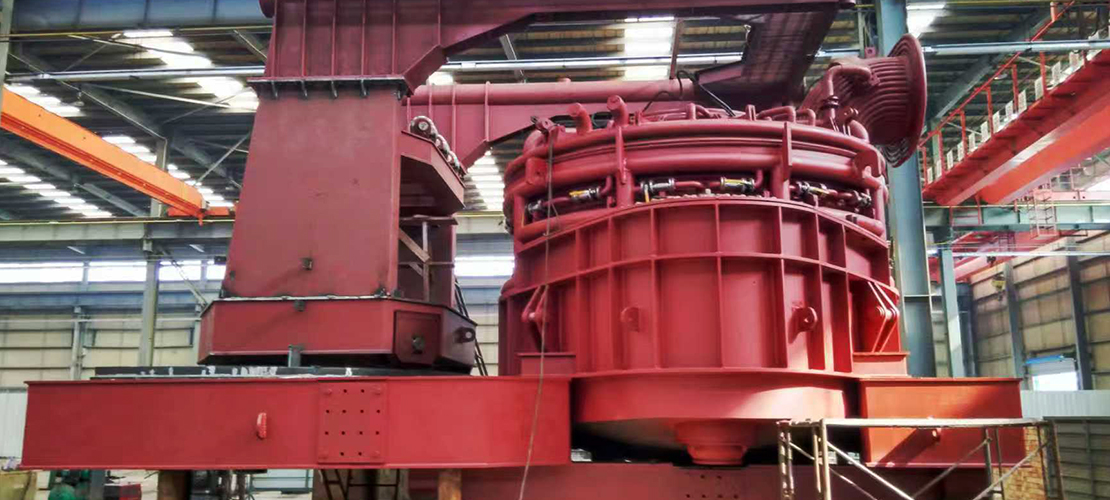Aug. 29, 2025

15t electric arc furnace is a type of steelmaking equipment used primarily for scrap steel, molten iron, or sponge iron. Using the heat generated by an electric arc, the furnace melts the raw materials to produce standard steel, high-quality carbon steel, alloy steel, and stainless steel.
It features a top-loading method with a swing-open lid and utilizes comprehensive energy utilization technologies, such as carbon-oxygen lances in the furnace door and cluster oxygen lances in the furnace wall, to achieve energy recycling and reduce power consumption.
The short-process steelmaking process, centered around the EAF-15t, generally includes raw material preparation, smelting, refining, tapping, and continuous casting/strip casting. The actual process may vary depending on the company's equipment, raw materials, steel grade, and production process requirements.
Raw Material Selection: Scrap steel is the primary raw material, supplemented by molten iron, sponge iron, or degreased iron as alloying and carbon sources. Raw materials can be 100% scrap steel, scrap steel + molten iron (pig iron), or scrap steel + sponge iron (DRI).
Raw Material Pretreatment: On-site removal of impurities (such as oil, aluminum, copper, and other unfavorable elements), sorting, weighing, and loading into the hopper according to the process mix.
Mixture Target: Achieve target carbon equivalent, deoxidizer, and alloying element content, ensuring furnace temperature control and carbon yield.
Pre-loading inspection: Ensure the electric arc furnaces lid seal, electrode condition, top system, enhanced cooling water system, and flue gas exhaust system are intact.
Charge Loading: Load scrap steel, molten iron/sponge iron, etc. from the hopper into the furnace chamber in sequence, ensuring even distribution of the material layer to avoid local overheating or uneven melt formation.
Discharge Ignition & Initial Melting: Electrode discharge generates heat to rapidly melt the scrap steel, forming a melt.
Carbon/Alloy Control: Depending on the caliber and process requirements, initial additions of carbon, manganese, silicon, aluminum, titanium, etc. are made through external charging or internal injection.
Temperature & Composition Control:
The carbon equivalent and chemical composition are adjusted by adding molten iron/sponge iron to the furnace.
Deoxidizers (such as aluminum and calcium iron silicon) are used for deoxidation to reduce the oxygen content of the molten steel and improve microstructure and composition uniformity.
Refractory & Atmosphere Management: Refractory materials are used in the EAF furnace roof, and the protection of the furnace roof and roof ensures refractoriness. If necessary, blowing is performed to improve the oxygen content and deoxidation effect.
Mechanical & Energy Control: Auxiliary systems such as furnace wall flow channels and bottom water/air spraying maintain the temperature distribution and suppress overheating.
Target Composition Correction: Trace elements (such as molybdenum, titanium, and niobium) are added in the EAF electric furnace or externally to achieve the target steel grade.
Deoxidation and Stabilization: Deoxidizers such as aluminum, titanium, and chromium are commonly used for deoxidation, and alloying is used to control grain refinement and carbide distribution.
Heat Treatability and Chemical Composition Optimization: During this stage, the content of elements such as carbon, silicon, manganese, nickel, and chromium is optimized to ensure the mechanical properties of the finished product.
Endpoint Determination: Online testing (such as furnace temperature, carbon content, oxygen content, and composition testing) is used to ensure that the molten steel meets the target.
Tapping Method: The molten steel is poured from the furnace mouth of the electric arc furnaces and fed into the downstream continuous casting machine or converted into ingots.
Furnace Bottom Treatment & Recovery: Residual slag in the furnace is removed and the furnace gas exhaust system is continuously monitored to prevent contamination.
Continuous Casting/Mold Casting: The molten steel is converted into ingots (bill, round, or slab) for forming in the continuous casting machine.
Pre-treatment for Hot Rolling: For hot rolling lines, the ingots undergo spraying, preheating, and cracking processes before entering the rolling process.
Online Quality Monitoring: Chemical composition, temperature, molten iron content, and deoxidation level are monitored online to ensure that the molten steel meets tapping specifications.
Safety & Environmental Protection: The furnace door, cover, flue gas exhaust system, waste gas treatment, and slag treatment must comply with environmental and safety regulations, and equipment maintenance and overhaul are performed continuously.
The 15t electric arc furnace can be used to produce ordinary steel, high-quality carbon steel, various alloy steels, and stainless steel.
For metallurgy equipment such as melting furnaces, if you have specific steel grades, target composition, and furnace configuration details (such as furnace structure, auxiliary blowing system, and continuous casting machine model), Sanrui Electric Furnace can provide a more precise solution based on your parameters.
Latest News
Energy Efficiency of Electric Arc Furnace Steelmaking
Sep. 01, 2025
EAF-15t Electric Arc Furnace Steelmaking Process
Aug. 29, 2025
Latest Products
Customized metallurgical machinery and equipment range: Electric Arc Furnace, Submerged Arc Furnace, LF Refining Furnace, Vacuum Furnace, Induction Furnace, Dust Remove System, Water Treatment Equipment, etc. Providing the most advanced equipment integration services, metallurgical equipment can be customized according to different needs of customers, and production capacity can be adjusted according to customer requirements.
Electric Arc Furnace
Submerged Arc Furnace
LF Refining Furnace
VD / VOD Vacuum Refining Furnace
Induction Furnace
Furnace Accessories
Navigation
E-mail: anna@srfurnace.com
Tel: +86 159 2955 5868
WhatsApp: +86 159 2955 5868
Add:
Room 102, Building 7A, Free Trade Xintiandi, Fengdong Avenue, Fengdong New Town, Xi'an City, Shaanxi Province
